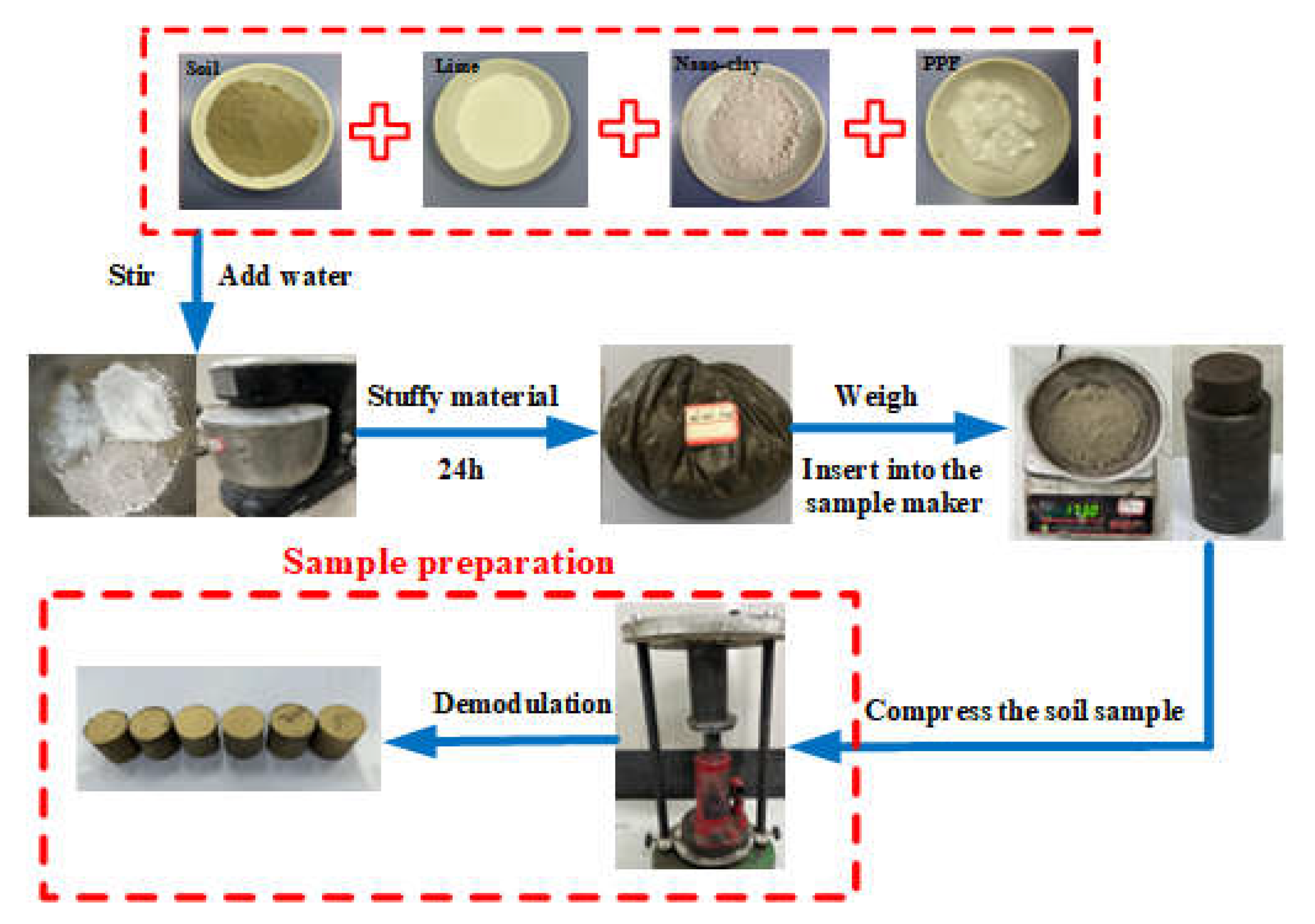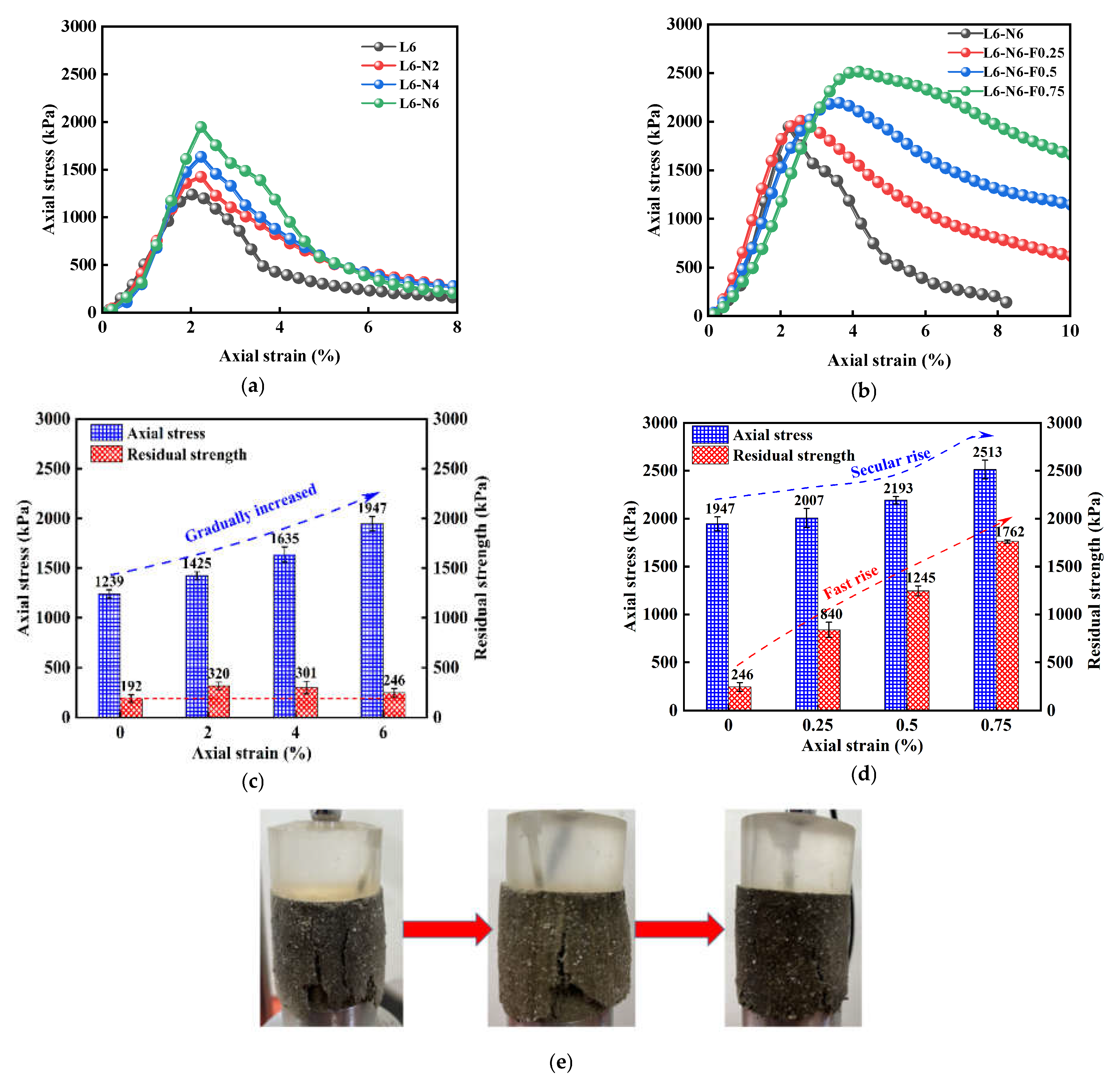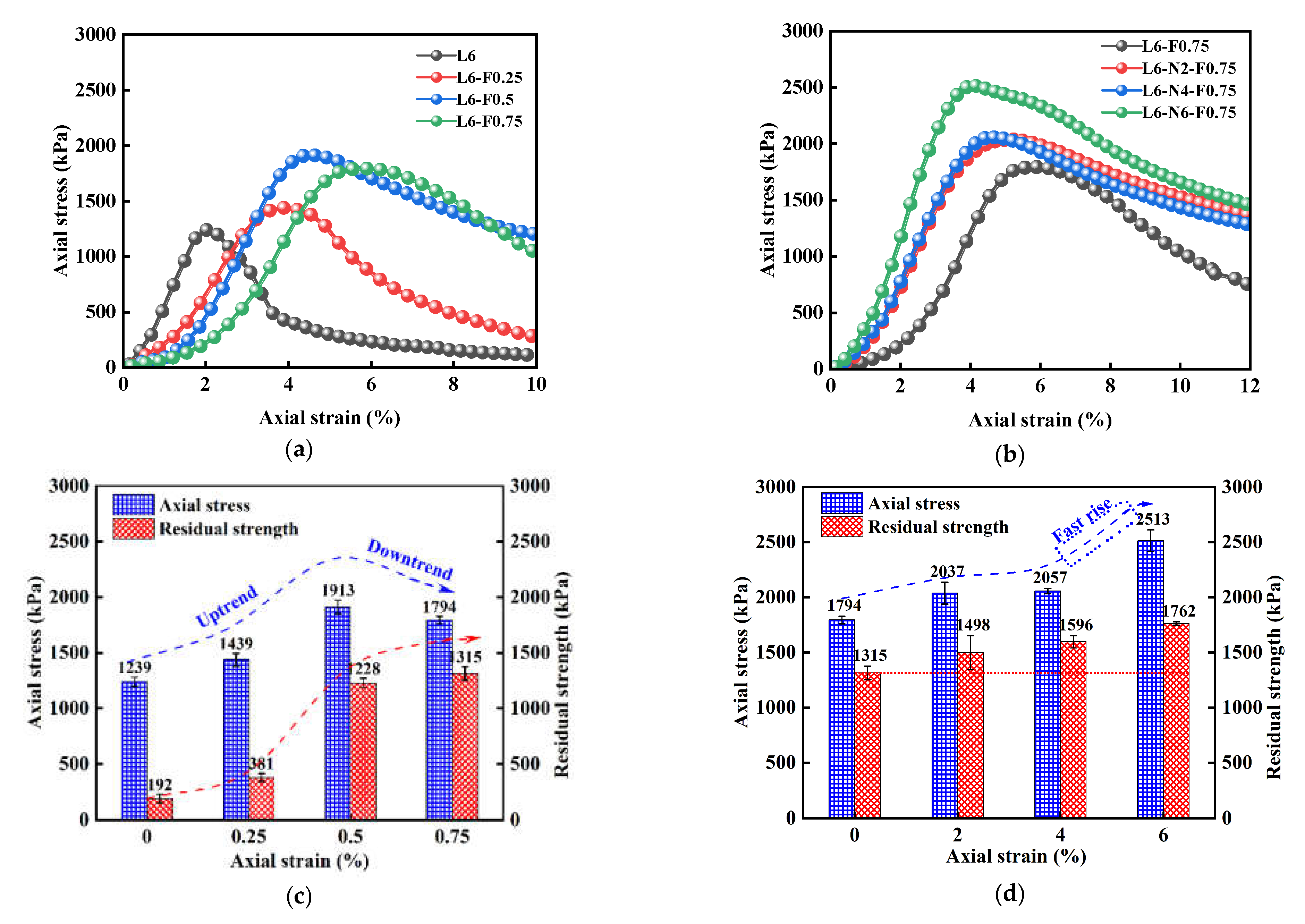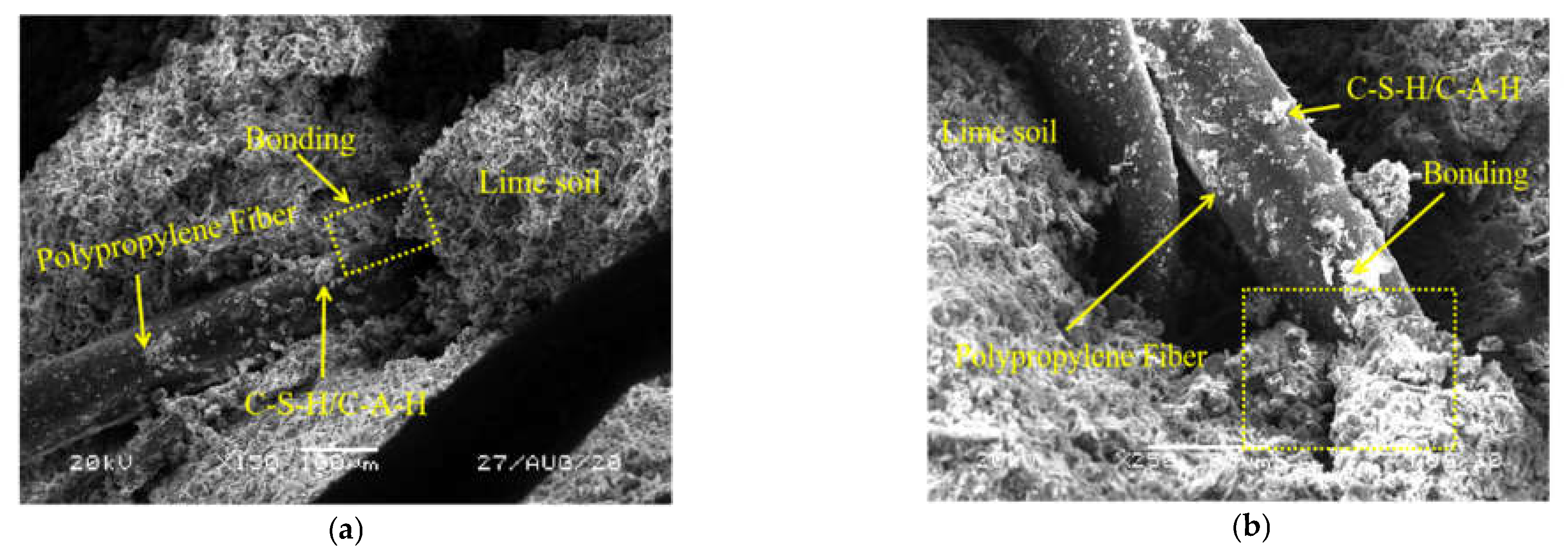The Elastic Modulus and Damage Stress–Strain Model of Polypropylene Fiber and Nano Clay Modified Lime Treated Soil under Axial Load
Abstract
:1. Introduction
2. Materials and Methods
2.1. Materials
2.2. Test Scheme
2.3. Stress–Strain Damage Model
3. Results and Discussion
3.1. Static Characteristics
3.1.1. UCS Test Results
3.1.2. Variation Law of Static Elastic Modulus
3.2. Dynamic Characteristics
3.2.1. Hysteretic Curve
3.2.2. Dynamic Elastic Modulus
3.2.3. Relationship between Static and Dynamic Elastic Modulus
3.3. Stress–Strain Damage Model and Damage Evolution Law of NFLS
4. Conclusions
- (1)
- Polypropylene fiber and nano clay can significantly modify the strength of LS. The growth rate of UCS and residual strength of NFLS is the most significant when the content of polypropylene fiber is 0.75% and the content of nano clay is 6%. On the one hand, nano clay can promote the reaction between lime and soil, and on the other hand, it can react with LS to produce cementitious materials such as hydrated calcium silicate and hydrated calcium aluminate. Nano clay and the generated cementitious material can fill the pores between fiber and soil, enhance the interfacial friction between fiber and soil, and improve the strength of NFLS. UCS can be increased by up to 103%. Polypropylene fiber enhances the ductility of NFLS, slows down the development of cracks, and improves its residual strength. The residual strength can be increased by 827%.
- (2)
- The static and dynamic elastic modulus of NLS, FLS, and NFLS are in functional relationship with the content of polypropylene fiber and nano clay. The addition of nano clay can improve the static and dynamic elastic modulus of NFLS and enhance the ability to resist deformation. In addition, the static and dynamic elastic modulus of NLS, FLS, and NFLS conform to linear, exponential, and logarithmic relationships respectively.
- (3)
- The meso random damage model can characterize the stress–strain relationship of NFLS under axial load. At the same time, the damage variable D can further explain the relationship between strain and NFLS damage and failure, and reflect the damage and failure of soil. When the strain is 10%, the rising trend of damage variable D of NFLS slows down with the increase of polypropylene fiber and nano clay content, and the damage variable D decreases with the increase of nano clay content, indicating that nano clay can improve the strength of NFLS. When the damage variable D is 0.8, the axial strain of NFLS increases with the increase of the content of polypropylene fiber and nano clay, and the axial strain increases from 8% to 12% with the increase of the content of polypropylene fiber, indicating that polypropylene fiber can improve the ductility of NFLS. Adding polypropylene fiber and nano clay can effectively improve the damage resistance of NFLS.
Author Contributions
Funding
Institutional Review Board Statement
Informed Consent Statement
Data Availability Statement
Conflicts of Interest
References
- Liu, Y.; Wang, Q.; Liu, S.; ShangGuan, Y.; Fu, H.; Ma, B.; Chen, H.; Yuan, X. Experimental investigation of the geotechnical prop-erties and microstructure of lime-stabilized saline soils under freeze-thaw cycling. Cold Reg. Sci. Technol. 2019, 161, 32–42. [Google Scholar] [CrossRef]
- Keybondori, S.; Abdi, E. Lime stabilization to improve clay-textured forest soil road subgrades. Int. J. For. Eng. 2021, 32, 112–118. [Google Scholar] [CrossRef]
- Dash, S.; Hussain, M. Lime Stabilization of Soils: Reappraisal. J. Mater. Civ. Eng. 2012, 24, 707–714. [Google Scholar] [CrossRef]
- Lemaire, K.; Deneele, D.; Bonnet, S.; Legret, M. Effects of lime and cement treatment on the physicochemical, microstructural and mechanical characteristics of a plastic silt. Eng. Geol. 2013, 166, 255–261. [Google Scholar] [CrossRef]
- Pu, S.; Zhu, Z.; Song, W.; Wan, Y.; Wang, H.; Xu, X. Comparative Study of Compressibility and Deformation Properties of Silt Stabilized with Lime, Lime, and Cement, and SEU-2 Binder. Arab. J. Sci. Eng. 2020, 45, 4125–4139. [Google Scholar] [CrossRef]
- Kutanaei, S.S.; Choobbasti, A.J. Triaxial behavior of fiber-reinforced cemented sand. J. Adhes. Sci. Technol. 2016, 30, 579–593. [Google Scholar] [CrossRef]
- Jiang, P.; Chen, Y.; Wang, W.; Yang, J.; Wang, H.; Li, N.; Wang, W. Flexural behavior evaluation and energy dissipation mechanisms of modified iron tailings powder incorporating cement and fibers subjected to freeze-thaw cycles. J. Clean. Prod. 2022, 351, 131527. [Google Scholar] [CrossRef]
- Khan, S.Z.; Rehman, Z.u.; Khan, A.H.; Qamar, S.; Haider, F. Effect of Polypropylene Fibers and Cement on the Strength Improvement of Subgrade Lying on Expansive Soil. IJST-T Civ. Eng. 2022, 46, 343–352. [Google Scholar] [CrossRef]
- Abdi, M.R.; Ghalandarzadeh, A.; Shafiei Chafi, L. An investigation into the effects of lime on compressive and shear strength characteristics of fiber-reinforced clays. J. Rock Mech. Geotech. Eng. 2021, 13, 885–898. [Google Scholar] [CrossRef]
- Ghasabkolaei, N.; Janalizadeh Choobbasti, A.; Roshan, N.; Ghasemi, S.E. Geotechnical properties of the soils modified with nanomaterials: A comprehensive review. Arch. Civ. Mech. Eng. 2017, 17, 639–650. [Google Scholar] [CrossRef]
- Niu, X.J.; Li, Q.B.; Hu, Y.; Tan, Y.S.; Liu, C.F. Properties of cement-based materials incorporating nano-clay and calcined nano-clay: A review. Constr. Build. Mater. 2021, 284, 122820. [Google Scholar] [CrossRef]
- Gao, L.; Ren, K.Y.; Ren, Z.; Yu, X.J. Study on the shear property of nano-MgO-modified soil. Mar. Georesour. Geotechnol. 2018, 36, 465–470. [Google Scholar] [CrossRef]
- Lin, D.F.; Luo, H.L.; Chen, C.T.; Cai, D. Study properties of soft subgrade soil stabilized by sewage sludge/lime and nano-SiO2. Geomech. Eng. 2016, 10, 793–806. [Google Scholar] [CrossRef]
- Theodoridou, M.; Charalambous, E.; Maravelaki-Kalaitzaki, P.; Ioannou, I. Amelioration of crushed brick—Lime composites using nano-additives. Cem. Concr. Comp. 2016, 68, 77–87. [Google Scholar] [CrossRef]
- Duran, A.; Navarro-Blasco, I.; Fernández, J.M.; Alvarez, J.I. Long-term mechanical resistance and durability of air lime mortars with large additions of nanosilica. Constr. Build. Mater. 2014, 58, 147–158. [Google Scholar] [CrossRef] [Green Version]
- Zhao, G.; Yan, H.; Yan, Y.; Gao, S.; Fan, D.; He, Y.; Wang, Y. Experimental study on the dynamic properties of lime-solidified soft soil under cyclic loading. Arab. J. Geosci. 2020, 13, 671. [Google Scholar] [CrossRef]
- Lu, Z.; Zhao, Y.; Xian, S.; Yao, H. Experimental Study on Dynamic Resilient Modulus of Lime-Treated Expansive Soil. Adv. Mater. Sci. Eng. 2020, 2020, 3272681. [Google Scholar] [CrossRef] [Green Version]
- Zhou, B.; Kong, L.-W.; Guo, A.G. Stress-strain-strength behaviour and constitutive description of lime-treated expansive soil. Rock Soil Mech. 2012, 33, 999–1005. [Google Scholar]
- Poinard, C.; Piotrowska, E.; Malecot, Y.; Daudeville, L.; Landis, E. Compression triaxial behavior of concrete: The role of the mesostructure by analysis of X-ray tomographic images. Eur. J. Environ. Civ. Eng. 2012, 16, 115–136. [Google Scholar] [CrossRef]
- Jiang, P.; Zhou, L.; Zhang, W.; Wang, W.; Li, N. Unconfined Compressive Strength and Splitting Tensile Strength of Lime Soil Modified by Nano Clay and Polypropylene Fiber. Crystals 2022, 12, 285. [Google Scholar] [CrossRef]
- Wang, M.; Xu, X.; Li, J.; Shen, F.; Yafeng, L. An experiment study on stress relaxation of unsaturated lime-treated expansive clay. Environ. Earth Sci. 2017, 76, 1–12. [Google Scholar] [CrossRef]
- Research Institute of Highway Ministry of Transport. Test Methods of Materials Stabilized with Inorganic Binders for Highway Engineering; China Communications Press: Beijing, China, 2009. [Google Scholar]
- Research Institute of Highway Ministry of Transport. Test Methods of Soils for Highway Engineering; China Communications Press: Beijing, China, 2020. [Google Scholar]
- Li, J.; Yang, W. Elastoplastic stochastic damage constitutive law for concrete. China Civ. Eng. J. 2009, 42, 31–38. [Google Scholar]
- Li, J.; Ren, X. Recent developments on stochastic damage mechanics for concrete. J. Build. Struct. 2014, 35, 20–29. [Google Scholar]
- Pakravan, H.; Latifi, M.; Jamshidi, M. Ductility improvement of cementitious composites reinforced with polyvinyl alcohol-polypropylene hybrid fibers. J. Ind. Text. 2014, 45, 637–651. [Google Scholar] [CrossRef]
- Jiang, P.; Zhou, L.; Mao, T.; Yuan, J.; Wang, W.; Li, N. Damage model and time effect of cement-modified waste slurry. J. Jilin Univ. 2021, 51, 1–8. [Google Scholar]
- Jiang, P.; Zhou, L.; Wang, Y.; Qian, B.; Wang, W.; Li, N.; Zhang, F. Freeze–Thaw Damage Model of Polypropylene Fiber Reinforced Cement Stabilized Waste Construction Slurry under Uniaxial Action. Minerals 2021, 11, 743. [Google Scholar] [CrossRef]
- Deb, S.; Mitra, N.; Majumder, S.B.; Maitra, S. Improvement in tensile and flexural ductility with the addition of different types of polypropylene fibers in cementitious composites. Constr. Build. Mater. 2018, 180, 405–411. [Google Scholar] [CrossRef]
- Wang, W.; Zhu, X. Study on strength property of nanometer silica fume reinforced cemented soil and reinforcement mechanism. Rock Soil Mech. 2004, 25, 922–926. [Google Scholar]
- Qian, B.; Yu, W.; Lv, B.; Kang, H.; Shu, L.; Li, N.; Wang, W. Mechanical Properties and Micro Mechanism of Nano-Clay-Modified Soil Cement Reinforced by Recycled Sand. Sustainability 2021, 13, 7758. [Google Scholar] [CrossRef]
- Song, X.; Xu, H.; Zhou, D.; Yao, K.; Tao, F.; Jiang, P.; Wang, W. Mechanical Performance and Microscopic Mechanism of Coastal Cemented Soil Modified by Iron Tailings and Nano Silica. Crystals 2021, 11, 1331. [Google Scholar] [CrossRef]
- Zheng, D.; Cui, H.; Tang, W.; Sang, G.; Lo, T.Y. Influence and mechanisms of active silica in solid waste on hydration of tricalcium aluminate in the resulting composite cement. Mater. Today Commun. 2021, 27, 102262. [Google Scholar] [CrossRef]
- Wang, J.; Chang, Z.; Tang, Y. Dynamic triaxial test analysis of reinforced gravel soil under cyclic loading. Rock Soil Mech. 2020, 41, 2851–2860. [Google Scholar]
- Wang, W.; Kang, H.B.; Li, N.; Guo, J.; Girma, D.Y.; Liu, Y. Experimental investigations on the mechanical and microscopic behavior of cement-treated clay modified by nano-MgO and fibers. Int. J. Geomech. ASCE 2022, 22, 04022059. [Google Scholar] [CrossRef]
- Kang, S.; Lee, B.; Kim, B.; Kim, Y. The effect of fibre distribution characteristics on the flexural strength of steel fibre-reinforced ultra high strength concrete. Constr. Build. Mater. 2011, 25, 2450–2457. [Google Scholar] [CrossRef]
- Jin, J.; Li, C.; Yuan, S.; Sun, Q.; Yang, H. Effect of fiber on early strength and interface stiffness of cemented tailings backfill. Mater. Res. Express. 2022, 9, 045202. [Google Scholar] [CrossRef]













| Natural Moisture Content (%) | Specific Gravity | Uniformity Coefficient Cu | Curvature Coefficient Cc | Liquid Limit (%) | Plastic Limit (%) | Plasticity Index (%) |
|---|---|---|---|---|---|---|
| 33 | 2.53 | 12.2 | 1.24 | 37.8 | 17.2 | 20.6 |
| NO | Lime Content (%) | Nano Clay Content (%) | PP Fiber Content (%) | Maximum Dry Density (g/cm3) | Optimum Moisture Content (%) | Compactness (%) | Curing Time (d) |
|---|---|---|---|---|---|---|---|
| LS | 6 | 0 | 0 | 1.762 | 17.5 | 98 | 7 |
| NLS | 6 | 2, 4, 6 | 0 | ||||
| FLS | 6 | 0 | 0.25, 0.5, 0.75 | ||||
| NFLS | 6 | 2, 4, 6 | 0.25, 0.5, 0.75 |
| NO | UCS (kPa) | Residual Strength (kPa) | Elastic Modulus (MPa) |
|---|---|---|---|
| L6 | 1239 | 192 | 81 |
| L6-N2 | 1425 | 321 | 89 |
| L6-N4 | 1635 | 301 | 117 |
| L6-N6 | 1947 | 246 | 122 |
| L6-F0.25 | 1439 | 381 | 66 |
| L6-F0.5 | 1913 | 1228 | 69 |
| L6-F0.75 | 1794 | 1315 | 55 |
| L6-N2-F0.75 | 2037 | 1498 | 66 |
| L6-N4-F0.75 | 2057 | 1596 | 65 |
| L6-N6-F0.25 | 2007 | 840 | 113 |
| L6-N6-F0.5 | 2193 | 1245 | 98 |
| L6-N6-F0.75 | 2513 | 1762 | 90 |
| NO | λ | ζ | η (%) |
|---|---|---|---|
| L6 | −3.5443 | 0.6054 | 1.0 |
| L6-N2 | −3.2778 | 0.4326 | 1.9 |
| L6-N4 | −3.1601 | 0.3403 | 2.5 |
| L6-N6 | −3.1448 | 0.2955 | 1.9 |
| L6-F0.25 | −3.2111 | 0.7107 | 3.3 |
| L6-F0.5 | −2.9546 | 0.7141 | 2.7 |
| L6-F0.75 | −2.8662 | 0.7064 | 3.6 |
| L6-N2-F0.75 | −2.8381 | 0.7826 | 0.5 |
| L6-N4-F0.75 | −2.9024 | 0.7730 | 1.5 |
| L6-N6-F0.25 | −2.9897 | 0.5031 | 1.6 |
| L6-N6-F0.5 | −2.6872 | 0.5547 | 1.3 |
| L6-N6-F0.75 | −2.6819 | 0.6176 | 0.8 |
Publisher’s Note: MDPI stays neutral with regard to jurisdictional claims in published maps and institutional affiliations. |
© 2022 by the authors. Licensee MDPI, Basel, Switzerland. This article is an open access article distributed under the terms and conditions of the Creative Commons Attribution (CC BY) license (https://creativecommons.org/licenses/by/4.0/).
Share and Cite
Wang, Z.; Zhang, W.; Jiang, P.; Li, C. The Elastic Modulus and Damage Stress–Strain Model of Polypropylene Fiber and Nano Clay Modified Lime Treated Soil under Axial Load. Polymers 2022, 14, 2606. https://doi.org/10.3390/polym14132606
Wang Z, Zhang W, Jiang P, Li C. The Elastic Modulus and Damage Stress–Strain Model of Polypropylene Fiber and Nano Clay Modified Lime Treated Soil under Axial Load. Polymers. 2022; 14(13):2606. https://doi.org/10.3390/polym14132606
Chicago/Turabian StyleWang, Zhichao, Weiqing Zhang, Ping Jiang, and Cuihong Li. 2022. "The Elastic Modulus and Damage Stress–Strain Model of Polypropylene Fiber and Nano Clay Modified Lime Treated Soil under Axial Load" Polymers 14, no. 13: 2606. https://doi.org/10.3390/polym14132606







